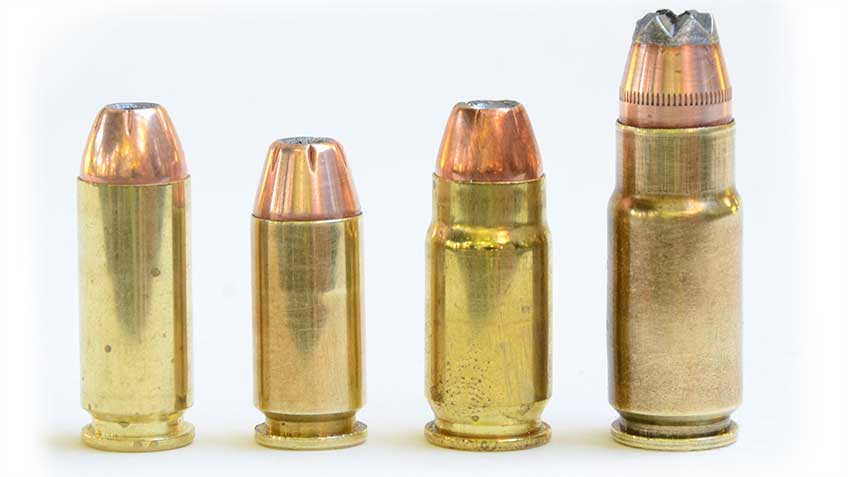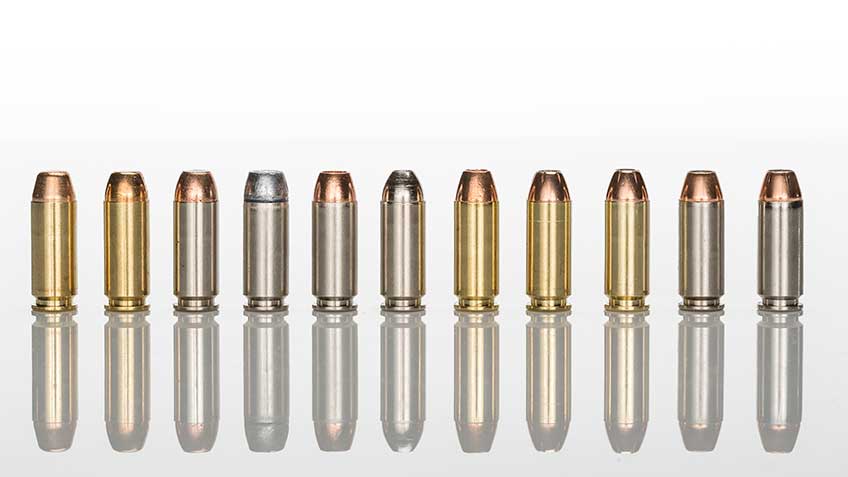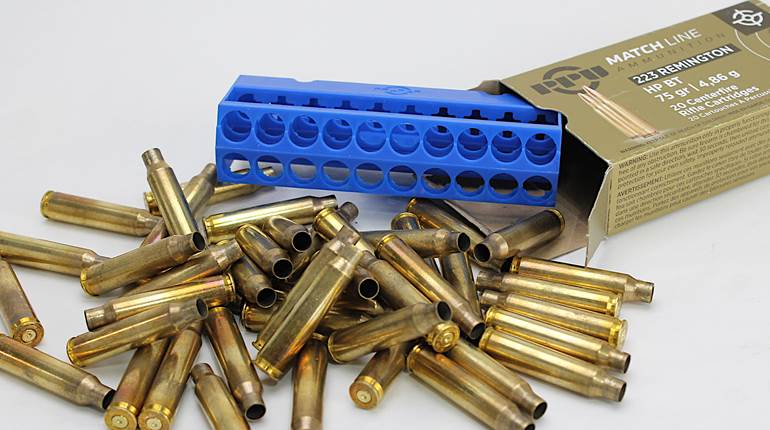
This article, "Resurgence of the 10mm Auto," appeared originally in the July 2015 issue of American Rifleman. To subscribe to the magazine, visit the NRA membership page here and select American Rifleman as your member magazine.
Powerful enough to be effective on deer-size game out to 75 yds. or so, the 10mm Auto has become a favorite of those who hunt wild pigs with hounds and who prefer a semi-automatic pistol of reasonable weight for concluding the chase with an up-close-and-personal shot to a vital area.
The alarming proliferation of such animals all across the country just about guarantees a level of popularity never before enjoyed by the 10mm Auto. It is fitting recompense for a cartridge whose life was nearly cut short by a series of circumstances that were not entirely its fault.
During the late 1960s, Guns & Ammo editor Whit Collins, along with fellow staffer John Adams, gunsmith John French and barrelmaker Irving Stone of Bar-Sto Precision Machine began their search for a cartridge suitable for use in the Browning High Power that was more powerful than the 9mm Luger for which it was chambered.
Their performance goal lay somewhere between the 9mm Luger and the .45 ACP. Two cartridges eventually emerged. The .40 G&A, formed by shortening and inside-reaming the .30 Rem. case, came along in 1972.

Five years later, the .40 G&A Mag., on a shortened .224 Wby. Mag. case, was introduced. A lathe was used to remove the belt from that case. Both cartridges were tested in modified Browning High Power pistols.
Muzzle velocity for 180-gr., 0.40" bullets made by Remington for the .38-40 Win. was said to be 1200 f.p.s. Reaching that velocity with a case measuring only 0.86" long obviously required rather high chamber pressures. Interestingly enough, the case length and an overall cartridge length of 1.17" were quite close to those of the .40 S&Ws which came along little more than a decade later.
Somewhere along the way, the offspring of the .30 Rem. case won out, except its length was increased to 0.992". Increasing bullet weight to 200 grs. was one of several suggestions made by Jeff Cooper, founder of the American Pistol Institute, or Gunsite Academy, who was a strong proponent of the M1911 pistol and who also held the CZ-75 in high regard.
For that reason, the Czech-built semi-automatic strongly influenced the design of a prototype pistol built around the .40-cal. cartridge by Thomas Dornaus, a pistolsmith at Pachmayr Gun Works at the time. Dornaus eventually formed a partnership with former police officer Mike Dixon to manufacture the gun under the name of Dornaus & Dixon.

Cooper suggested calling the new pistol the Bren Ten with the acronym “Bren” referencing Brno, the Czechoslovakian armsmaker, and Great Britain’s Enfield arsenal. The Bren Ten, chambered for the 10mm Auto cartridge, was introduced in 1983, and Norma of Sweden was contracted to load the ammunition.
I visited the Norma factory four years later and met with company ballistician Sixten Holmquist who was involved with the 10mm Auto’s development from the very beginning.
According to him, initial Dornaus & Dixon specifications called for 170- and 200-gr. bullets at 1,400 and 1,300 f.p.s. muzzle velocities, respectively. Reaching that level of performance required loading the cartridge to a mean average pressure of 37,000 p.s.i. with a maximum of 44,400 p.s.i.
Upon receiving the first lot of test ammunition, the boys at D&D immediately discovered that chamber pressures were too high for their pistol, so they instructed Norma to back off the throttle on future shipments. The reduction in pressure lowered velocities considerably.

At the factory, I observed 170- and 200-gr. ammunition being tested in a 5" pressure barrel. Ten-shot averages were 1,246 f.p.s. and 1,115 f.p.s., respectively. Some Norma ammunition was also loaded with a 165-gr. JHP at an advertised 1,400 f.p.s, but I never had the opportunity to shoot any of it.
Needing operating capital for the company, the original plan was to sell 2,000 Jeff Cooper commemorative editions at a price of $2,000 each. Buyers did not exactly storm the factory with cash in hand, so a standard pistol was made available for $500. The Dual Master version with an extra slide and barrel in .45 ACP was offered for an additional $300.
For various reasons, with financial difficulties near the top of the list, production of the Bren Ten ceased in 1986. Estimates vary on how many were shipped, but it was probably fewer than 2,000. The magazines may be even rarer than the guns.
Had the 10mm Auto not become available in the Colt Delta Elite in 1987, it might now be pushing up daisies. Colt later offered it in the Double Eagle as well. Springfield Armory soon unveiled the 10mm Auto Omega, basically the grand old M1911 with a linkless barrel similar to that of the Browning Hi Power.

Federal Ordnance, Smith & Wesson, Auto-Ordnance, Irwindale Arms, L.A.R. Mfg., Glock and others eventually followed with 10mm self-loading pistols of their own. Ruger joined the fun with a Blackhawk convertible with interchangeable cylinders in .38-40 Win. and 10mm Auto. The use of half-moon clips enabled Smith & Wesson to offer the 10mm in its Model 610 revolver.
The next big boost for the 10mm Auto came in November of 1989 when FBI director William Sessions announced that the bureau was adopting a reduced-velocity loading with a 180-gr. bullet at 975 f.p.s. Shortly thereafter, Smith & Wesson was awarded a contract for 9,500 autoloading pistols chambered in 10 mm Auto.
Then came the contract spoiler. Competitive shooter and Smith & Wesson employee Tom Campbell had already discovered that the performance of the FBI load could be duplicated in a shortened version of the 10mm Auto.
Doing so would allow it to be used in smaller and lighter semi-automatic pistols designed for the 9mm Luger. Introduced in January 1990 as the .40 S&W, it went on to dominate the law enforcement market and became a top seller among the civilian population as well.
Today, there is no scarcity of 10mm Auto ammunition as it is available from Federal, Barnes, Remington, Hornady, Buffalo Bore, Cor-Bon, Double-Tap, Armscor, Winchester, Pro Load, Wilson Combat, Georgia Arms and perhaps others I have unintentionally overlooked. Most recently, SIG Sauer added it to the company’s own line of ammunition.
The cartridge is also an excellent candidate for handloading. Reloading dies are available from Lyman, RCBS, Redding, Hornady, Lee and others. When putting together light target loads, I find Bullseye, Tightgroup and Zip propellants hard to beat. Others, including Silhouette, Blue Dot, Accurate No. 7, Vihtavuori 3N37, Longshot and Autocomp are great for full-power loads.

In addition to excellent jacketed bullets from Sierra, Hornady, Barnes, Speer and Nosler, molds for casting bullets of several weights and styles are offered by Lyman and RCBS. When preparing handloads for this project I used a set of Lyman dies. A Redding Competition 10X powder measure proved capable of throwing small charges of propellant with minimal variation in charge weight. I also used Starline cases and CCI primers.
When it came to developing and testing the accompanying loads, the lowest velocity recorded with any of the pistols was 1,040 f.p.s., with the highest coming in at 1,369 f.p.s. out of the Nighthawk Custom gun, which is not surprising considering its extra inch of barrel. Group sizes as small as 0.79", again, from the Nighthawk Custom, prove that the 10mm Auto is plenty accurate for hunting. Even the largest average for five-shot groups was under 2".
So while the 10mm Auto has had its ups and downs through the years, it has proven itself to be somewhat of a survivor. It will likely never come close to equaling the popularity of the .45 ACP, 9mm Luger or .40 S&W, but the number of companies and shops offering loads and guns for it today indicate that it is far from dead.
Shooting the 10mm Auto
While a number of gun companies offer the 10mm chambering—EAA, Wilson Combat, Glock and STI Int’l. come to mind—the guns are not always readily available; but I did manage to round up four to test a variety of loads throughout several days.
They were: a Colt Delta Elite, a Dan Wesson RZ-10 Razorback, a Nighthawk Custom Heinie and a Rock Island Armory Tactical 2011 G10. All had 5" barrels except for the Nighthawk, which had a 6" tube. A break-in session came first with 100 rounds of handloads fired in each of the guns. To avoid shooter fatigue as much as possible during the accuracy testing, only one gun was shot during each test session.

As is to be expected from an M1911-style pistol in its price range, the Heinie Longslide from Nighthawk Custom topped them all in accuracy. My wife says I can pick nits with the best of them, but I’ll just be darned if I could find anything wrong with the gun.
Prior to shipment from its Berryville, Ark., shop, all Nighthawk Custom M1911 pistols must prove capable of shooting five bullets inside 1" at 15 yds. from a sandbag rest. I managed to break the 1" average barrier with only one load—at a distance of 25 yds.
I grew especially fond of its crisp, buttery-smooth trigger and long sight radius. If ever there was a perfect up-close-and-personal wild porker gun, this is it. Pigs can be legally taken at night in my home state, so the light rail on its dust cover was a welcome feature.

With the exception of its Pachmayr wraparound rubber grip, Commander-style hammer, dual recoil springs and 10 mm Auto chambering, Colt’s Delta Elite of 1987 was the same as the standard Series 80 Government Model in .45 ACP.
Today’s version has a stainless steel slide and frame, and with the exception of a relief cut through the left-side rail just above the slide stop window, it is no different than the first one I shot just over a quarter-century ago.
Of the four guns requested for this report, the Colt arrived last and, having already shot the others with their beavertail grip safeties, extended thumb safeties and extended magazine catches, I had some adjusting to do, but it didn’t take long. Unlike the other three pistols tested, the Colt does not have a ramped barrel.

The Rock Island Armory gun was the only one with a heavy, bushingless barrel and a full-length steel recoil spring guide. Those, along with a dust cover extending out to the muzzle of the slide, actually increased weight beyond that of the Nighthawk Custom longslide.
The additional heft really made its presence known when shooting the 180-gr. Buffalo Bore load, which exceeded 1300 f.p.s. in all four guns. Cocking serrations at the front of the slide made it easier than the other guns to retract against the heavy recoil spring required by the 10 mm Auto. The RIA gun also has an accessory rail on its frame. All things considered, the price is most definitely right—$660.

Dan Wesson was acquired by CZ-USA in 2005 with firearms produced at the factory in Norwich, N.Y., where they have been made since 1996. Various styles of M1911 pistols are offered, with the stainless steel Razorback in 10 mm Auto being the latest.
Unlike the dual recoil springs of Colt’s Delta Elite, the Razorback has a single 23-lb. spring. Its most noticeable detail is a rib with a serrated surface machined into the top of the slide, much like on Colt Gold Cup pistols of yesteryear.
The front sight is dovetailed to the slide, and like the Colt Delta Elite, its rear sight is drift-adjustable for windage. Lacking elevation adjustment proved to be no handicap as the Razorback shot close enough to dead-on at 25 yds. with all loads.








































